Leon Schlesinger Studio, MGM, and UPA, for the First Motion Picture Unit (1943-1945), Thunderbean (December, 2010), 1 disc, Approx. 120 mins, 4:3 ratio, Dolby Digital 2.0 mono, Not Rated, Retail: $15.95
Storyboard:
A lazy and bumbling army private demonstrates the trouble one can cause when not following the rules. These World War II gems were made specifically for viewing by enlisted men, and feature the talents are a surprising variety of creators.

The Sweatbox Review:
(Portions of this review were originally seen in our review of Image and Bosko Video’s The Complete Uncensored Private Snafu.)
During World War II, some of animation’s brightest talents contributed to the War effort by making films for the United States military. Walt Disney’s contributions to the War effort are fairly well known and appreciated, with his artists providing propaganda films for public consumption, and various materials to the military including insignia designs and much more; but Walt’s studio was not the only one involved in working with the U.S. military, of course. In times of war, everyone pitches in to get the job done. Our subject here is a film series which had such legendary talents working on it as Frank Capra, Dr. Seuss, Chuck Jones, Friz Freleng, Mel Blanc, and Carl Stalling.
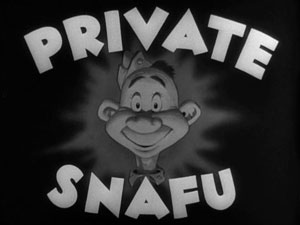
Private Snafu was the brainstorm of Hollywood director Frank Capra, best known now for the films It’s A Wonderful Life and Mr. Smith Goes To Washington. Capra was heading the Armed Forces’ First Motion Picture Unit when he thought up a general idea to use an animated cartoon character as an instrument for teaching lessons to the troops. Many of the GI’s were very young of course, and were naïve in the ways of war and the world. They also had varying degrees of education and experience, so the idea was to present material in a fun manner that would both entertain and educate. Cartoon shorts were still very popular in movie theaters then, and they seemed like a natural way to achieve Capra’s goals. The cartoons would be attached to the Army Navy Screen Magazine newsreel that went overseas.
Capra asked Ted “Dr. Seuss” Geisel to lead the animation section in the Unit, and to develop the Private Snafu idea. Bids were tendered from animation studios, with Disney given the inside track. Disney, however, wanted to own the new character and to have merchandising rights, which was not acceptable. Plus, their bid was quite high. Instead, the job was won by the Leon Schlesinger studio, producer of the Looney Tunes and Merry Melodies series distributed by Warner Bros. Schlesinger’s bid was a fraction of Disney’s (somewhere between a half and a third), and made no insistence of owning the character. The cartoons would be made in black and white to keep the cost down, but would be provided the talents of the best talent that Schlesinger had to offer: directors Friz Freleng, Chuck Jones, Frank Tashlin, and Bob Clampett; music director Carl Stalling; and voice artist supreme Mel Blanc. The raucousness of the Schlesinger gang was the perfect group to make cartoons meant to appeal to servicemen. While on the surface anarchic and defiant of authority, their Snafu cartoons still managed to effectively get the point across that rules and regulations serve important purposes.
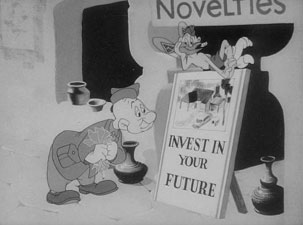
Other Snafu cartoons would be made elsewhere later on, partially due to conflicts between the Unit and Schlesinger about costs. UPA, MGM, and the Harman-Ising studio each made contributions to the series, with some films also being started that were never completed. Bill Hanna and Joe Barbera reportedly worked on one (called Hot Spots) with Tex Avery’s unit at MGM, but the completed animation was never put to film since the war ended at that time. Other shorts, called Secrets Of The Caribbean and Mop Up, were also made but never shown; they are now unfortunately considered to be lost. All told, the Snafu cartoons cost nearly $300,000.
The name “Snafu” came from an acronym that was especially popular among the troops back then, and is still recognized by many today, even if they don’t realize it’s an acronym. SNAFU stands for “Situation Normal All F***ed Up”. In the cartoons, Snafu is generally shown doing things wrong, whether due to laziness or ignorance, and it was hoped that the troops in the audience would learn from his mistakes. If nothing else, they were treated to some terrific unofficial Looney Tunes cartoons that would not be seen by outsiders for many years.

Speaking of which, current viewers should be aware that you can certainly tell that these cartoons were not made for general audiences. They were not subject to the censors in Hollywood, and were made to appeal to young men. This means there is a little bit of near and partial nudity on display, and some light cussing (like “hell”). Although quite tame by today’s standards, the content of these cartoons may surprise those accustomed to viewing the cartoons of Daffy Duck and Porky Pig. There is also the issue of racial caricatures. Germans generally do not get drawn too badly, but the Japanese characters seen in the cartoons all have squinty eyes and overbites. The viewer should keep in mind that such caricatures were done throughout cartoons and comic strips at the time, and served to dehumanize “the enemy”, as well as to make them seem less threatening.

The Cartoons
Coming! Snafu! – Chuck Jones directed this introduction to the character, with a stripper dream included to get the troops’ attention.
Gripes – Friz Freleng introduces Snafu’s conscience: the cigar-chomping, stubble-ridden and winged Technical Fairy, First Class. Snafu is given his own command to address his gripes. The result is more babes on base, but no discipline.

Spies – Snafu as a blabber. Adolf Hitler himself makes an appearance, and also lends his visage to the devil himself.
The Goldbrick – This presents the evil of laziness, with a new “angel” turning into a wartime caricature, in the first “Snafu” by Frank Tashlin.
The Infantry Blues – Snafu learns that being a “dogface” ain’t so bad, as the other Services don’t have it too swank either.
Fighting Tools – Bob Clampett’s first “Snafu” shows the importance of taking care of your weapon. An unprepared Snafu tangles with a German. The recurring “jackass” imagery of these cartoons (with the animal seen from behind) makes an appearance here.
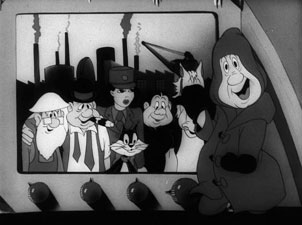
The Home Front – Snafu finds out that people back home are making a contribution too. There’s quite a funny “nuts” gag in this one that would never dare appear in any Looney Tunes cartoon.
Rumors – Well, rumors are sure dangerous.
Booby Traps – It doesn’t take much imagination to guess where animators could take these gags!

SNAFUperman – Decades before Superman and Bugs Bunny were corporate brothers, we see the Looney Tunes animators doing a Superman pastiche. Snafu and the audience learn why map-reading is an important skill.
SNAFU vs. Malaria Mike – This cartoon is naturally about the dangers of mosquitoes carrying disease. This cartoon gives us a good view (several times) of Snafu’s bottom end.
A Lecture on Camouflage – The Technical Fairy gives this lecture. Even if you’re bored, you may wish to stick around for the topless mermaids.
Gas – Mask safety, with a Bugs Bunny cameo.

Going Home – Another fable about keeping secrets to yourself.
The Chow Hound – A story of a cow’s mission to feed the troops, and Snafu’s wastefulness. (Don’t you know there are starving kids in occupied Europe?)
Censored – Censorship by the unit’s censorship office, as well as self-censorship, helps to save lives.
Outpost – Working at a remote outpost may be boring, but it’s important work. Even reporting a tin can sighting can be important.
Payday – Snafus gambles and buys hookers, instead of saving for his future.
Target SNAFU – Another malaria cartoon, but with a new twist: A mosquito squadron trains to attack the US troops.
Three Brothers – Here we have an introduction to Snafu’s two brothers, Tarfu (Things Are Really F***ed Up) and Fubar (F***ed Up Beyond All Repair). Snafu finds out that his brothers also work hard in their parts of the Services. We start to see recycling of themes now, as this message is similar to that in The Infantry Blues. Bugs Bunny makes another cameo.
Private SNAFU In The Aleutians – Travelogue, with a Jimmy Durante seal.

It’s Murder She Says… – Less Snafu here, but a return to the malaria message. The structure of this one, at least, is still interesting. We meet a lady mosquito treated as a fading movie star.
Hot Spot – The Devil stars in this humorous travelogue about Iran.
Operation: SNAFU – Imagine a Bugs Bunny cartoon, but with espionage and Japanese instead of carrots and Elmer Fudd. This one is pretty much devoid of a message, and is the most routine of all those in the set. It’s still pretty good, though.
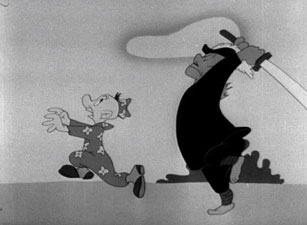
No Buddy Atoll – Snafu versus a Japanese admiral on a small island.
Private SNAFU Presents Seaman TARFU In The Navy – This 1946 cartoon, focusing on Snafu’s brother, looks at Navy life. This was directed by Bruce Gordon at Harman-Ising.
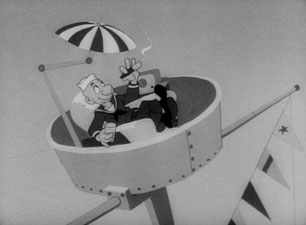
A Few Quick Facts
Some 1944-45 entries came out under the heading of A Few Quick Facts and were produced at MGM and UPA. They had less of Snafu and are a little different stylistically, but they served much the same purpose as the earlier ones. Of course, without the Schlesinger gang, they were more straight-forward and less fun.

The first two in this section are from MGM, and make minimum use of Snafu. The MGM shorts were NOT on the previous Image/Bosko DVD. US Soldier/Bullet/Diarrhoea & Dysentery only has Snafu appearing at the end to teach us about gastrointestinal difficulties, USS Iowa/Brain/Shoes barely has Snafu in a cameo at the end. Still, their inclusion makes this disc just that much more complete.
The UPA cartoons make better use of Snafu (and were on the earlier disc). The animation is also more creative now, but the story a lot drier. A Few Quick Facts: Inflation brings in Snafu right away, and gives us a new narrator. A Few Quick Facts: Fear is another straight but visually interesting UPA effort.

Overall, the first half of the program is really quite good, like slightly raunchy Looney Tunes cartoons with militaristic messages. By the second half, things get a little repetitive, and the MGM and UPA ones have a different tone altogether. At their best, though, these cartoons are slickly animated, very funny, and epitomize what was best about the old Warner Bros. cartoons: humorously imperfect characters, perfect timing, sharp writing, great voice work, and wonderfully complementary music. Plus, the whimsical writing of Dr. Seuss is often apparent in the rhyming dialog. Whether looking at these as a window into the past, or strictly as entertainment, these cartoons make for great viewing.
Is This Thing Loaded?
The previous Image/Bosko release had no special features aside from some text material, but Thunderbean’s disc serves up numerous bonuses.
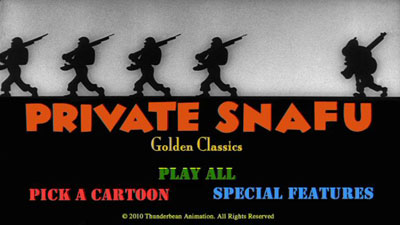
Still Galleries provide images from Snafu’s appearances in magazines (check out those Ray Harryhausen covers!!!), a model sheet, and dozens of storyboard drawings.
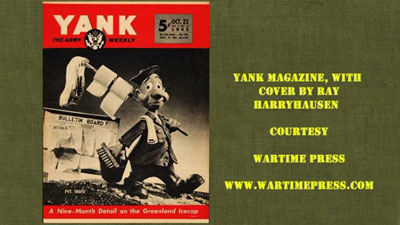
A Few Quick Facts About Snafu, With Jerry Beck (3:54) has Mr. Beck narrating a history of the cartoons over various clips, basically going a little more in-depth than the already fine liner notes in the package.

Some of the A Few Quick Facts segments appeared in more than one edition of Army/Navy Screen Magazine. Alternative Soundtrack USS Iowa (3:06) provides different narration for one such segment that appeared more than once.
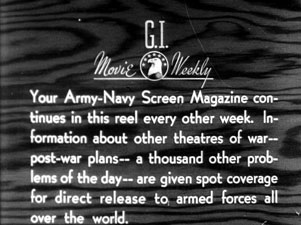
Army/Navy Screen Magazine Titles (2:19) gives you the chance to see the opening and end segments for both Army/Navy Screen Magazine and its predecessor The War.
Audio Commentaries appear for twelve of the cartoons, with the delightful Rumors getting two. Contributors include such knowledgeable folk as Jerry Beck, John Kricfalusi, Mike Kazaleh, Eric Goldberg, and Mark Mayerson. Having watched these cartoons many times in the past, listening to the commentaries is a great excuse to view them yet again— as if one needed an excuse.

Case Study:
Thunderbean provides their disc with a standard Amaray case, and a 4-page insert that gives information about the cartoon series, and a rundown of the cartoons, with directors and dates. Placing these cartoons into context is essential, so it’s good to see such an effort being made.
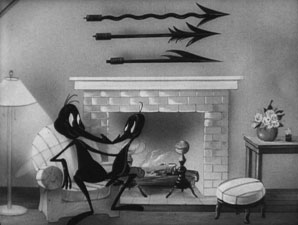
And look at that cover! I was going to ask Thunderbean who provided the terrific and exceptionally well designed cover art, but the signature is plain to see (also credited in the DVD’s insert). It’s by none other than animator and director supreme Eric Goldberg, with unspecified contribution by Mel Miller. Very nice job on that cover, gentlemen.
Ink And Paint:
This is a big step up from the earlier DVD, as Thunderbean was able to gain access to the original 35mm materials being held at the United States National Archives. The cartoons have undergone restoration, and surely we now have the best possible set of these cartoons. Compared to the older DVD, the cartoons now appear much sharper, as well as having way fewer instances of dust and wear overall. That is not to say that they look pristine by any stretch of the imagination, and the quality varies, but they appear way better than they have before. It is easy to overlook a few scratches while admiring the deep blacks, distinct lines, and richer shades of grey. Some cartoons do have continuous vertical lines from projector wear, or a steady stream of other defects, while others look quite good. Compared to what we’ve seen before, most viewers should be quite pleased with the overall quality.


In these examples, screen captures from my old review of the Image/Bosko set appear first, with the corresponding Thunderbean image on the right. In addition to the clear distinction in video quality, it should also be noted that the older disc had an intermittent Bosko Video “bug” in the lower right-hand corner, and those cartoons were also extremely window-boxed, leaving a thick grey frame around the cartoons. Thunderbean does do some mild window-boxing of the shorts, but it is much more reasonable, and the outline is in black, so it’s not so noticeable. The Thunderbean image also tends to have more image content.


Scratch Tracks:
The two-channel mono is quite good. I noted no significant distortion, and no hissing. As you might expect, there are no alternate languages or subtitles.

Final Cut:
It is hard to imagine any classic animation fan not wanting this DVD. The combination of the Looney Tunes crew and Dr. Seuss, plus much improved video over the previous disc available, makes this a must-own, as well as a recommended upgrade if you held the earlier DVD. Moving beyond that, Thunderbean offers a nice suite of extras that place the cartoons in context and add great value to the disc. Of all the wonderful Thunderbean releases out there, this may be the one that can most appeal to a mass audience, in addition to being nirvana to discerning cartoon buffs.
 | ||
 |









